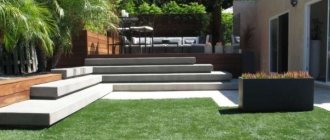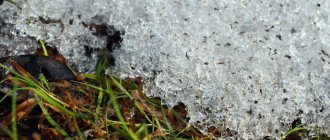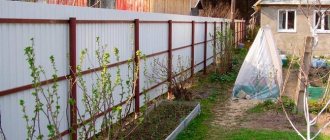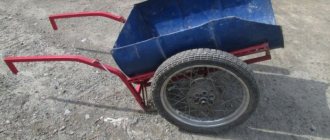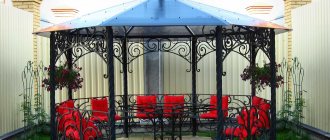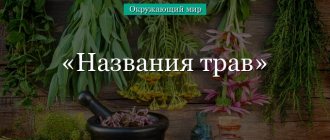Review author: Terrari School of Design
This type of lawn is a convenient alternative to natural lawn. Artificial turf is used when it is not possible to beautifully decorate the area with natural turf: maintenance is impossible or the soil has features that prevent a natural green carpet.
More often this type is used to decorate playgrounds, tennis courts, football fields and other sports games. Artificial turf is also not neglected for the purpose of landscape decoration.
In areas where natural grass will not have the desired effect (swimming pool area, floors in greenhouses or greenhouses, terraces), such a carpet can be successfully laid out. Despite all the unnaturalness, the characteristic plastic sheen is absent. This is achieved by two combinations of two fiber colors.
What is artificial grass made of?
Most often, artificial grass is produced using tufting technology, which is used in the manufacture of carpets. During the production process, long threads - blades of grass - are woven into the base of the lawn using a special device. These fibers are made from polyethylene or propylene with the addition of polyamide. The length of the blades of grass may vary. The most optimal size is considered to be up to 3 cm.
The base of the lawn, into which the fibers are woven, is also made of polypropylene, only denser. After the blades of grass are woven into the base, it is coated with molten latex. This makes it more elastic.
Is artificial grass dangerous for pets?
Dog or cat owners often have questions about the safety of artificial turf for pets. A lawn made of propylene or polyethylene is absolutely harmless to your pets. These materials are non-toxic, so even if swallowed they will not cause any harm to animals. In addition, cats are not interested in them at all.
Animals, by the way, will also not be able to harm the lawn. Thanks to the secure attachment of the blades of grass to the base, a dog or cat will not be able to tear it, even if they dig diligently. They will also not be able to crush the coating: drooping blades of grass quickly rise and are restored.
Pet urine is another sensitive issue. It can destroy a real lawn, creating “burnt out” spots on it, but for a high-quality artificial lawn it does not pose a great danger. Urine seeps through the base and goes directly into the gravel base, leaving no stains or damage to the grass.
The lawn is not afraid of any other pollution left by pets. You can easily remove them with plain water.
Alternative option
If you compare photos of artificial turf and natural grass, it is unlikely that anyone will immediately notice the difference. Artificial lawns are being made very well these days. The coating reliably reproduces the appearance and texture of grass growing in its natural environment.
Typically, “alternative” grass is sold in rolls, which are quickly rolled out on a prepared site. For example, you can choose artificial turf from Leroy Merlin in 2x5 m rolls for only 2,498 rubles.
There are also rectangles of artificial grass surfaces and cut-to-length canvases according to the required sizes.
What is artificial grass infill
After laying the artificial lawn, it is covered with filler. It protects the grass, helps it maintain its shape longer and increases the lifespan of the lawn. The filler holds the blades of grass in an upright position, making the lawn look as natural as possible. They scatter it using special devices. In small areas this is done manually: after scattering, the lawn is combed using a rake - this way the filler is evenly distributed between the blades of grass.
Quartz sand and rubber crumbs are most often used as filler.
- Quartz sand is homogeneous in composition, coarse-grained, allows water to pass through well and does not contain harmful impurities. Due to its low cost it is very popular. It tolerates any kind of precipitation and mechanical loads well. The disadvantage of quartz sand is its rapid washout.
- Crumb rubber is quite elastic, so it protects well from injury, which is important on sports and playgrounds. Like quartz sand, the crumbs allow water to pass through perfectly. It is made from car tires and painted dark green or brown.
Materials required for installation
To properly lay artificial turf, you will need the following:
- Rolls or rectangles of covering.
- Substrate.
- Quartz sand.
- Seam tape.
- Brush.
- Knife.
- Putty knife.
- Glue.
The coating can be laid on any type of base - earth, brick, concrete, wood, etc.
Is it difficult to lay artificial turf?
To lay this coating, you do not need to have any special skills, but for some types of work it is better to have an assistant nearby. The procedure for laying artificial turf consists of several stages:
- Clear the future lawn area of debris, stones and weeds. If necessary, organize a drainage system to drain excess water so that there are no puddles on the lawn after rain.
- Level the soil and compact it using a roller, a large log, or any other method, making a slight slope to allow water to drain.
- Spread the covering, laying each row 1-1.5 cm on the previous one. Trim the edges and leave the lawn for 12 to 24 hours to allow it to fully straighten.
- Place connecting tape at the joints and coat it with glue. Place the edges of both parts of the lawn on the tape, being careful not to let any fluff get inside, and roll it with a roller or press it down with something heavy. For additional reliability, the joints can be secured with staples.
- Fill the lawn with filler and spread it evenly over the surface.
- Remove all debris from the lawn and rake it.
Gluing the canvas
Once you are sure that the lawn fabric lies flat and has no defects in the form of swellings or bumps, you can begin gluing the parts together.
To glue parts of the lawn together, special connecting tapes (sutures), about 30 cm wide, and polyurethane glue are used.
The tape is placed under the edges of adjacent parts, glue is applied to it with a notched trowel, the edges of the sheets are lowered, and the seams are pressed with a roller or heavy pipe of a suitable diameter.
The work should be done carefully, avoiding getting glue on the lawn fibers.
If the lawn area is large, it is advisable to additionally secure the seams with staples.
Is it possible to lay artificial turf on concrete?
Artificial turf can be laid not only on the ground, but also on other substrates, such as concrete or tiles. If you have a very small plot and you cannot devote a lot of space to a full-fledged lawn, but you want to admire the emerald grass, lay an artificial lawn on the terrace. Often artificial turf is laid on concrete in the patio - it is both beautiful and practical.
The procedure for laying artificial turf on different bases differs little from each other and consists of the steps listed above. The only difference is that when laying green covering on a solid base, you first need to lay a 1 cm thick substrate, and then lay artificial grass on it. The underlay will reduce the load on the fibers, which means it will extend the life of the lawn.
FAQ
How to correctly calculate the costs of purchasing grass and installation?
+
When planning a purchase, it is necessary to take measurements of the area where the artificial grass will be installed. In order not to make mistakes in the calculations, we also recommend taking into account the costs of purchasing glue, backfill material and fastening tape.
Why is backfill needed?
+
Laying artificial grass requires not only clearing an area of the required size and securely connecting the modules. After the main work has been carried out, the surface is covered with sand or rubber granules. This helps to give the pile resistance, compact the backing and increase comfort during use.
Artificial grass heats up
One of the main disadvantages of artificial turf is that the grass becomes very hot in hot weather. For example, on a hot summer afternoon, a lawn located in an open area can heat up to 40 and even 50°C! However, it's not all bad.
Firstly, if you have the opportunity, then lay the lawn not in an area that is lit all day, but in a place where the sun's rays reach only in the morning and evening - and the problem of artificial grass being too hot will disappear by itself. You can create artificial shade by installing an awning over your resting place.
Secondly, if the grass is laid near the pool and splashes of water are constantly flying from there, the lawn will also not heat up much: it will be cooled by the water.
Thirdly, some modern types of lawn do not have this disadvantage at all: the temperature of high-quality artificial turf is approximately equal to the temperature of natural grass located in the same conditions. Of course, they cost more.
How to clean artificial turf
One of the important advantages of artificial turf is that it is easier to care for: it does not need to be cut, watered, fertilized, weeded, aerated or scarified. However, you cannot leave it completely without maintenance - artificial grass needs to be cleaned from time to time. This is especially true for coatings that are located under trees or near flower beds. The debris from them spills onto the grass and gives the lawn an unkempt appearance.
How to clean artificial turf? Everything is simple here: take a broom or rake and remove all the debris with these tools. To stabilize the fibers, run a broom over the lawn from time to time, pointing it against the grain. Also, water your lawn occasionally. It will wash away dust, small debris and pet urine. If your pet gets into the habit of going to the same place on the lawn, then to discourage it, first wash the grass with vinegar and then rinse with water.
Advantages and disadvantages of coating
The advantages of a “fake” lawn include:
- durability, which is ensured through the use of synthetic fibers;
- practicality and wear resistance;
- a wide range of colors, allowing you to implement any design solutions in personal plots;
- waterproof;
- resistance to frost, moisture and trampling;
- easy to maintain, as it does not require weeding, watering, or sowing;
- aesthetics. Artificial grass retains its original qualities for a long time. It does not fade in direct sunlight and does not become deformed from walking.
There are practically no disadvantages to synthetic green lawns. The only thing is that such a lawn has a high cost, but it fully justifies itself during long-term use.
What are the benefits of artificial turf?
Now let's summarize and list the most important advantages of artificial turf:
- it requires only minimal care, so it saves a lot of time;
- the presence of artificial turf also has a positive effect on the family budget: there is no need to spend money on gasoline for a lawn mower, on the purchase of fertilizers and on water for irrigation;
- it is good at any time of the year and does not depend on the vagaries of the weather: it does not fade in the sun, does not rot from endless rains, does not “shed” after winter, etc.;
- With the help of artificial turf you can easily and quickly improve the most difficult area of your territory.
It is difficult to say for sure which lawn is better - natural or artificial. Many summer residents, despite the difficulties with a natural lawn, refuse to replace it with an artificial one. However, artificial turf is finding more and more fans among extremely busy people. Everyone chooses what they like.

